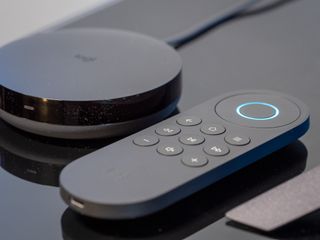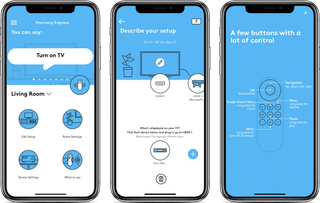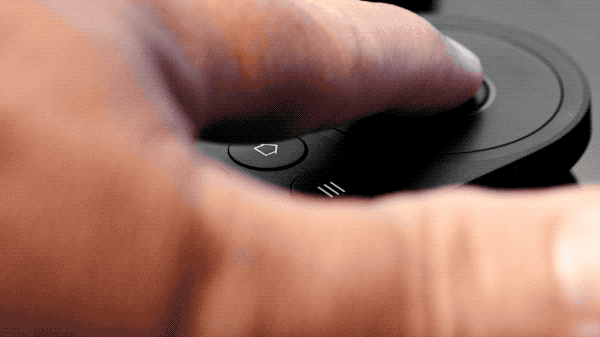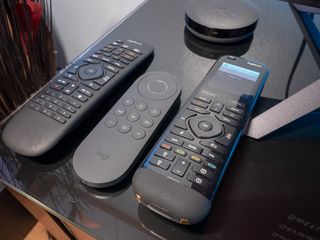
There are three distinct parts that make up the total experience of a remote control.
First, there's the matter of setup — getting the remote to properly talk to your TV and whatever is connected to it. Then there's the matter of how it works once that part is handled. The third part is the remote control itself.
If any one of those parts should come up short, the entire experience pretty much falls flat.
The new Harmony Express (which retails for $249 at Amazon but almost certainly will be on sale at some point) is Logitech's latest attempt to navigate that minefield. And guiding the way is — you guessed it — Amazon Alexa. The Express itself is a cleverly simple remote, especially when you look at it alongside Logitech's other offerings.
They're not a bad pair, Alexa and Logitech, and one I've expected for quite some time. For as much as I've recommended the likes of the Logitech Harmony Companion remote for years now (an eternity in the tech world), the company has — until now — missed out on the voice assistant bandwagon. It's tied in quite nicely to Alexa and Google Assistant on the server side of things, but neither was actually built in to any of Logitech's remotes.
Spend even just a few minutes with the Harmony Express, and it's pretty easy to get the lay of the land.

Speak to me
Alexa makes it easier. Sometimes.
The Harmony Express is a simple-looking remote that trades myriad buttons for a simple layout — and has Amazon Alexa built in.
The Good
- It's Logitech's first real remote with voice control
- Small size, with a simple design
- Setup process is improved over older remotes
The Bad
- Still requires nerding out over your hardware
- Not all devices and services have deep Alexa integration
- Cost will be prohibitive until it goes on sale
It's complicated ...
Logitech Harmony Express The Setup
Logitech has a lot of experience with the universal remote experience. Still, there's really only so much it can do with the first and second hurdles in our scheme. Discovering and manipulating the myriad devices connected to your TV will always be a pain point, short of some miraculous universal solution.
Various methods of auto-discovery (CEC, a deep library of products, and prayer, mostly) go a long way toward making the process as easy as possible. And Harmony Express has a new, dedicated app to guide you through that process, available for Android and iOS . The gist is pretty much the same as it was previously. Teach it what you have hooked up, and what you need to watch and hear what you want to watch and hear.

This new iteration attempts to automate creating what we'd previously call an "activity." We'll use my bedroom as the example here. I have a Vizio TV and sound bar (both a few years old now), and an Apple TV 4K . Once those three devices have been added (only the Apple TV was discovered automatically, but adding the Vizio kit was only as difficult as looking up the model numbers), I didn't have to do anything else. Sure, I had to tell the Express app which TV input to use, and that I utilize the sound bar for audio. But I didn't have to manually set up any activities beyond that — nor did I have to add them to any buttons on the remote.
You'll also have to log in to the Logitech app itself (you can use Google or Amazon or your own login), and you'll also have to install the Harmony Skill for Amazon Alexa, so everything will place nice with each other.
That's still a whole lot of steps, and it's going to be daunting for a lot of folks. That's not a knock on what Logitech has accomplished, though. It's made the best of what's still a fairly complicated procedure, and the new app deserves credit for that. It's simpler and more visually compelling than its predecessor, and let's hope there's some sort of merging of the two at some point.

Alexa is great — until it's not
Logitech Harmony Express In Use
Funny thing about Logitech's remotes — I use, maybe, a half-dozen buttons on the Harmony Companion or the Harmony Elite. I don't have cable or satellite, therefore I don't need numbers. And while the Harmony Express looks pretty spare — because it most definitely is — it also has all the buttons I need.
But this is the annoying part where the usual caveat will apply: Your experience will vary a good bit depending on your setup.
I don't have cable or satellite TV. Your TV may be newer or older than mine. You might use different streaming video apps.
The simple fact is that any universal remote control of this sort can — and will — be bottlenecked by the APIs of whatever it is you've connected to it. Actually, even more so because the Harmony Express relies on Amazon Alexa to do so much heavy lifting.
https://twitter.com/mdrndad/status/1118169844799758336
A quick and easy example: I can press the voice button and say "Open YouTube" and Alexa knows to open up YouTube. But if I say "Open YouTube TV," Alexa has no idea what to do. (It doesn't really matter if that's Alexa's fault, or Logitech's fault, or Apple TV or Roku's fault. The fact is it doesn't currently work.)
So your experience very much will vary based on your preferences. When it works? It's not bad at all. When it doesn't work, well, it doesn't work. And Alexa will tell you that it doesn't work.
All in all, it's not a bad voice experience. But ... it's also still a voice experience. And because of the simplicity of the remote itself (more on that in a second), it relies heavily on that voice experience for things like changing inputs, and turning on the TV in the first place. (Good luck with that if you occasionally fight insomnia with a spouse sleeping next to you.)
The simple fact is that voice control can be a great option . But it shouldn't ever be the only option for controlling things .




Tiny remote is tiny
Logitech Harmony Express The Hardware
A few more things on the hardware itself.
You'll find a couple things in the box. There's the remote control, which very much looks and feels like a small, plastic remote control. I've long sung the praises of the Harmony Companion and its curvy design — and I still say it's one of the best-designed devices in my home. The Harmony Express, on the other hand, is pretty run of the mill. It looks and feels pretty inexpensive — OK, I'll even say cheap — and doesn't really stand out from what we've seen from other remotes, like the Amazon Fire TV, or even the old Nexus Player. (The latter is what I'm most reminded of.)

Also in the box is a puck-shaped "blaster" that does most of the heavy lifting. It's what connects to the internet and fires off infrared signals to all of your devices. (The remote connects to it via Bluetooth LE.) It's also pretty glossy and attracts dust as if it never was tested outside of a clean room.
And that's that. The remote only has nine buttons (OK, 10 if you count the Alexa/OK button), and that's actually kind of a nice thing in 2019, and long-presses will add to the number of actions they can perform. (Pro tip: Hold down the mute button to turn all of your devices off.)
I wouldn't exactly say the remote control itself is all that inspiring, but there are some nice little details. Like the backlit keys, and the ability to use the Harmony Express app to help find your remote when it falls between the couch cushions. (Why can't I just use another Alexa device to trigger that, though?) And because Alexa is built in, you can use the remote to do anything else Alexa can do. You'll just have to press the button first, of course.

The bottom line
Logitech Harmony Express Should You Buy It?
The Harmony Express finds itself in a precarious position, and mostly not of its own fault.
First, consider the price. It retails at $249, which puts it between the $349 Harmony Elite, and the $159 Harmony Companion. But the thing is that neither the Elite nor the Companion actually costs that much. At the time of this writing, the Elite is going for $269 on Amazon, and the Companion a mere $104. You can pair the latter with a full Amazon Echo Plus and get pretty much the same functionality — plus a decent audio speaker — for just about the same $249. Or get yourself a Harmony Companion and an Echo Dot for about $145 out the door, and treat yourself to a decent meal.
For a universal remote with voice control, Harmony Express is the clear choice.
And therein lies the problem with all this voice-command technology — whether it's Amazon Alexa or Google Assistant or Apple's Siri. If it's already baked into everything , there's not all that much incentive to pay extra to have it built into a certain something — in this case a remote control. And that's a shame, because Logitech's execution really isn't to blame here. It's a pretty good remote, done about as well as you could hope.
But if you have a newish setup — Roku, Apple TV, Android TV or Amazon Fire TV — you almost certainly already have remotes with voice control that also work within the limits of their respective ecosystems. So why upgrade?
If you're looking for a universal remote that can control all the things — and do so by voice — Harmony Express is the clear choice. It controls all your TV stuff. Having Alexa built in means it can do all the things Alexa can do, and control all the things Alexa can control.
But so, too, can so many other things that you may already own — or that don't cost $249 to duplicate functionality.

Universal Remote
Alexa makes it easier.
The Harmony Express is a simple-looking remote that trades myriad buttons for a simple layout — and has Amazon Alexa built in.
Also great remotes ...

